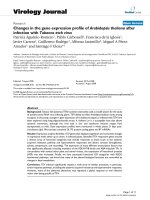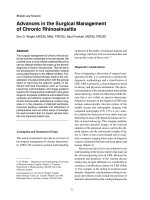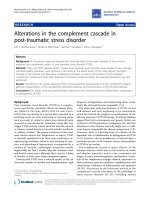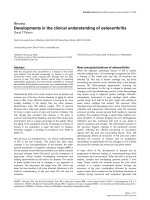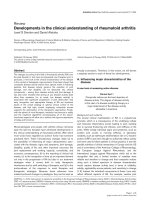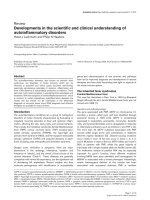Báo cáo y học: "Changes in the expression of NO synthase isoforms after ozone: the effects of allergen exposure" doc
Bạn đang xem bản rút gọn của tài liệu. Xem và tải ngay bản đầy đủ của tài liệu tại đây (403.54 KB, 7 trang )
BioMed Central
Page 1 of 7
(page number not for citation purposes)
Respiratory Research
Open Access
Research
Changes in the expression of NO synthase isoforms after ozone: the
effects of allergen exposure
An-Soo Jang*
1
, Inseon-S Choi
2
, Jong-Un Lee
3
, Sung-Woo Park
1
, June-
Hyuk Lee
1
and Choon-Sik Park
1
Address:
1
Department of Internal Medicine, Soonchunhyang University Hospital, Bucheon, 1174, Jung-dong, Wonmi-gu, Bucheon-si, Gyeonggi-
do, 420-767 Republic of Korea,
2
Research Institute of Medical Sciences, Department of Internal Medicine, Chonnam National University, 8, Hak-
1-dong, Gwangju, 501-757, Republic of Korea and
3
Physiology, Chonnam National University Medical School, Chonnam National University, 5,
Hak-1-dong, Gwangju, 501-757, Republic of Korea
Email: An-Soo Jang* - ; Inseon-S Choi - ; Jong-Un Lee - ; Sung-
Woo Park - ; June-Hyuk Lee - ; Choon-Sik Park -
* Corresponding author
Nitric oxide synthaseOzoneAsthma
Abstract
Background: The functional role of nitric oxide (NO) and various nitric oxide synthase (NOS)
isoforms in asthma remains unclear.
Objective: This study investigated the effects of ozone and ovalbumin (OVA) exposure on NOS
isoforms.
Methods: The expression of inducible NOS (iNOS), neuronal NOS (nNOS), and endothelial NOS
(eNOS) in lung tissue was measured. Enhanced pause (P
enh
) was measured as a marker of airway
obstruction. Nitrate and nitrite in bronchoalveolar lavage (BAL) fluid were measured using a
modified Griess reaction.
Results: The nitrate concentration in BAL fluid from the OVA-sensitized/ozone-exposed/OVA-
challenged group was greater than that of the OVA-sensitized/saline-challenged group.
Methacholine-induced P
enh
was increased in the OVA-sensitized/ozone-exposed/OVA-challenged
group, with a shift in the dose-response curve to the left, compared with the OVA-sensitized/
saline-challenged group. The levels of nNOS and eNOS were increased significantly in the OVA-
sensitized/ozone-exposed/OVA-challenged group and the iNOS levels were reduced compared
with the OVA-sensitized/saline-challenged group.
Conclusion: In mice, ozone is associated with increases in lung eNOS and nNOS, and decreases
in iNOS. None of these enzymes are further affected by allergens, suggesting that the NOS
isoforms play different roles in airway inflammation after ozone exposure.
Introduction
Asthma is an inflammatory disease of the airways that is
characterized by airway obstruction and increased airway
responsiveness [1]. NO (nitric oxide) is a short-lived
Published: 05 June 2004
Respiratory Research 2004, 5:5
Received: 22 May 2003
Accepted: 05 June 2004
This article is available from: />© 2004 Jang et al; licensee BioMed Central Ltd. This is an Open Access article: verbatim copying and redistribution of this article are permitted in all media
for any purpose, provided this notice is preserved along with the article's original URL.
Respiratory Research 2004, 5 />Page 2 of 7
(page number not for citation purposes)
molecule that causes vasodilation and bronchodilation. It
is synthesized from L-arginine by three forms of the
enzyme NO synthase: two constitutive NO synthases
(cNOS) are involved in the physiological regulation of air-
way function, and an inducible form of the enzyme
(iNOS) is involved in inflammatory disease of the airways
and in host defense against infection [2,3].
We previously demonstrated that NO metabolites were
increased in tracheo-bronchial secretions of asthmatic
subjects in parallel with asthma severity, and that NO
metabolites in sputum are a more valuable indicator for
monitoring asthmatic airway inflammation than those in
serum [4,5].
Ozone is an important component of the photochemical
oxidation product of air pollution emitted from automo-
bile engines [6]. Acute ozone exposure decreases pulmo-
nary function, increases airway hyper-responsiveness
(AHR), and induces airway inflammation in dogs [7],
guinea pigs [8], and humans [9-11]. NO may play a criti-
cal role in ozone-induced pulmonary inflammation or
damage. We reported that the nNOS isoform might be
involved in airway obstruction in mice exposed to ozone
[12]. The functional roles of neuronal NOS (nNOS),
endothelial NOS (eNOS), and iNOS in the murine model
of asthma with ozone exposure are uncertain.
This study investigated the roles of the individual NOS
isoforms and evaluated the relationship between NO
metabolites and lung function using barometric whole-
body plethysmography (WBP) in mice after ozone and
allergen exposure.
Methods
Mice
Female BALB/c mice (DaeMul Laboratories, Daejeon,
Korea) known to IgE-high responder, aged 5 to 6 wk, were
used. The mice were maintained on ovalbumin free diets.
The mice were individually housed in rack-mounted
stainless steel cages with free access to food and water.
Ovalbumin-induced allergic airway disease model
An ovalbumin (OVA)-induced allergic airway disease
model of asthma with some modification was used [13].
Briefly, mice were sensitized by means of intra-peritoneal
injection of on day 1, 14 d with 10 µg of Grade V OVA
(Sigma Chemical, St Louis, Mo) and 1 mg of aluminum
potassium sulfate (Sigma Chemical) in 500 µL of saline
solution. Mice were then challenged on days 21 to 23 by
daily exposure (30 min) to an aerosol of 1% (wt/vol) OVA
in saline solution. Vehicle control mice were sensitized
with a suspension of aluminum potassium sulfate (1 mg)
in saline solution (500 µL) and challenged with nebulized
saline solution daily from days 21 to 23. Aerosol chal-
lenge was carried out on groups of up 20 mice in a closed
system chamber attached to an ultrasonic nebulizer (NE-
UO7; Omron Corporation, Tokyo, Japan) with an output
of 1 mL/min and 1- to 5-µm particle size.
Ozone exposure
The mice housed in whole-body exposure chambers were
exposed to ozone concentrations of 2 ppm for 3 h (n = 6),
which dose and time of ozone was selected according to
our previous study [14]. Ozone was generated with
Sander Model 50 ozonizers (Sander, Eltze, Germany). The
concentration of ozone within the chambers was moni-
tored throughout the exposure with ambient-air ozone
motors (Model 49C; Thermo Environmental Instruments
Inc., Franklin, Mass). The air-sampling probes were placed
in the breathing zone of the mice. The mean chamber
ozone concentration ( ± SEM) during the 3 hr exposure
period was 1.98 ± 0.06 ppm. The breathing parameter val-
ues of spontaneously breathing BALB/c mice were deter-
mined under standard conditions at room air and
temperature.
Determination of airway responsiveness
Airway responsiveness was measured by barometric
plethysmography using whole body plethysmography
(Buxco, Troy, NY) immediately after ozone exposure
while the animals were awake and breathing spontane-
ously as a modification of the method described by
Hamelmann et al [15]. Penh measured in mice using bar-
ometric plethysmography is a valid indicator of bronchoc-
onstriction and can be used to measure AHR [15-17].
Bronchoconstriction is known to alter breathing patterns,
and changes in Pause (timing of early and late expiration)
and Penh are really due to alterations in the timing of
breathing, as well as prolongation of the expiratory time.
Furthermore, airway constriction increases the thoracic
flow asynchronously with the nasal flow, resulting in an
increase in the box pressure signal. Penh is an empiric
parameter that reflects changes in the waveform of the
measured box pressure signal that are a consequence of
bronchoconstriction. Before taking readings, the box was
calibrated with a rapid injection of 150 µl air into the
main chamber. Measured were pressure differences
between the main chamber of the WBP containing the
animal, and a reference chamber (box pressure signal).
This box pressure signal is caused by volume and resultant
pressure changes in the main chamber during the respira-
tory cycle of the animal. A pneumotachograph with
defined resistance in the wall of the main chamber acts as
a low pass filter and allows thermal compensation. The
time constant of the box was determined to be approxi-
mately 0.02 s. Mice were placed in the main chamber, and
baseline readings were taken and averaged for 3 min.
Respiratory Research 2004, 5 />Page 3 of 7
(page number not for citation purposes)
Bronchoalveolar lavage (BAL) fluid preparation and
analysis
BAL was performed immediately after the last measure-
ment of airway responsiveness. The mice were deeply
anesthetized intraperitoneally with 50 mg/kg of pentobar-
bital sodium and were killed by exanguination from the
abdominal aorta. The trachea was cannulated with a pol-
yethylene tube through which the lungs were lavaged
three times with 1.0 ml of physiologic saline (4.0 ml
total). The BAL fluid was filtered through wet 4 × 4 gauze.
Trypan blue exclusion for viability and total cell count was
performed. The BAL fluid was centrifuged at 150 × g for 10
min. The obtained pellet was immediately suspended in 4
ml of physiologic saline, and total cell numbers in the BAL
fluid were counted in duplicate with hemocytometer
(improved Neubauer counting chamber). Then, a 100 µl
aliquot was centrifuged in a cytocentrifuge (Model 2 Cyt-
ospin; Shandon Scientific Co., Pittsburg, PA). Differential
cell counts were made from centrifuged preparations
stained with Diff-quick, counting 500 or more cells in
each animal at a magnification × 1,000 (oil immersion).
OVA-specific IgE
Serum was obtained by means of orbital bleeding of anes-
thetized mice on day 25 of the sensitization-challenge
protocol, 24 hrs after the final OVA or saline challenge.
Serum was stored in 100-µL aliquots at -73°C until proc-
essed for measurement of OVA-specific IgE. OVA-specific
IgE levels were quantitated by using ELISA, as previously
described [18]. Briefly, flat-bottomed, 96-well ELISA
plates (Immuno Maxisorp; Nalge Nunc International,
Roskilde, Denmark) were coated overnight at 4°C with
100 µg/mL OVA in coating buffer (NaHCO
3
, 1.94 g/L;
NaCO
3
, 3.52 g/L; and dH
2
O, 1 L [pH9.6]). After 3 washes
with 0.5% Tween-20/PBS plates were blocked with 200
µL/well of 1% BSA/PBS for 1.5 hrs at 37°C. After 6 washes
with 0.5% Tween-20/PBS, serum samples (1:10, 1:50, and
1:100 dilutions in 1% BSA/PBS) were incubated for 1.5
hrs at 37°C. Pooled sera from OVA sensitized-challenged
mice served as a positive control, and pooled normal
mouse sera served as a negative control. After 6 washes
with 0.5% Tween-20/PBS, 100 µL/well of sheep anti-
mouse IgE (1:8000 in 1% BSA/PBS, Calbiochem-Novabi-
ochem Corp, La Jolla, Calif) was added for 1.5 hrs at
37°C. After 6 washes with 0.5% Tween-20/PBS, 100 µL/
well of horseradish peroxidase-conjugated rabbit anti-
sheep IgG (1:2000 in 1% BSA/PBS, Cabiochem-Novabio-
chem Corp) was added for 1.5 hrs at 37°C. After a further
6 washes with 0.5% Tween-20/PBS, 100 µL/well of TMB
substrate was added to each well. The color reaction was
stopped 20 to 30 minutes later by addition of 100 µL/well
2 mol/L H
2
SO
4
. ODs were read at 450 nm, with a refer-
ence wavelength of 620 nm. Levels of OVA-specific IgE in
serum samples were expressed in arbitrary units (AUs),
where 1 AU equals the OD of the 1:50 dilution of the pos-
itive control sera. Serum OVA-specific IgE levels were then
interpolated from the linear part of the OD versus AU
standard curve of the positive control sera.
Measurement of nitrite and nitrate production
Nitrite production was quantified colorimetrically after
the Griess reaction as described by Greenberg et al [19].
BAL fluid supernatant, or standard (100 µL), was reacted
with an equal volume of Griess reagent (1% sulfanila-
mide/0.1% naphthylethyllenedihydrochloride/2.5%
phosphoric acid, Sigma Chemical Co.) in duplicate
microtiter wells at room temperature. Chromophore
absorbance at 540 nm was determined. Nitrite concentra-
tion was calculated using sodium nitrite (BDH Chemical
Co.) as a standard. To assay sample nitrate, 200 µL BAL
fluid supernatant, or standard containing 100 µL of 200
mM ammonium formate (including 100 mM HEPES,
Sigma Chemical Co.) was reduced to nitrite at 37°C for 1
hr by adding 100 µL nitrate reductase [E. coli
(ATCC25922), American Type Collection, Rockville,
MD], followed by centrifugation to precipitate nonreact-
ing E. coli for 5 min, after which the nitrite was quantified
as described above.
Western blot analysis
The lung was rapidly isolated following saline, ozone
exposure for 3 h, and ozone and OVA challenge was rap-
idly frozen. The lung tissues were homogenized at 3000
rpm in a solution containing 250 mmol/L sucrose, 1
mmol/L ethylenediaminetetra-acetic acid, 0.1 mmol/L
phenylmethylsulfonyl fluoride, and 10 mmol/L Tris-HCl
buffer, at pH 7.6. Large tissue debris and nuclear frag-
ments were removed by two low-speed spins in succession
(1000 × g for 10 min and 10,000 × g for 10 min). Protein
samples (100 µg) were loaded and electrophoretically
size-separated with a continuous system consisting of a
12.5% polyacrylamide resolving gel and 5% polyacryla-
mide stacking gel. The proteins were then electrophoreti-
cally transferred to a nitrocelluose membrane at 20 V
overnight. The membranes were washed in Tris-based
saline buffer (pH 7.4) containing 0.1% Tween-20 (TBST),
blocked with 5% nonfat milk in TBST for 1 hour, and
incubated with a 1:750 dilution of antirabbit polyclonal
bNOS, eNOS, iNOS antibody (Transduction Laboratories,
Lexington, KY, USA) in 2% nonfat milk/TBST for 1 h at
room temperature. The membranes were then incubated
with a horseradish peroxidase-labeled goat antirabbit IgG
(1:1200) in 2% nonfat milk in TBST for 2 hours. The
bound antibody was detected by enhanced chemilumi-
nescence (Amersham, Little Chalfont, Buckinghamshire,
UK) on hyperfilm. The relative protein levels were deter-
mined by analyzing the signals of autoradiograms using
the transmitter scanning videodensitometer.
Respiratory Research 2004, 5 />Page 4 of 7
(page number not for citation purposes)
Statistical analysis
All data were analyzed using the SPSS version 7.5 for Win-
dows. Data are expressed as mean ± SEM. Inter-group
comparisons were assessed by non-parametric method
using Mann-Whitney U test. A p-value of less than 5% was
regarded as statistically significant.
Results
Methacholine induced AHR and OVA specific IgE
The OVA-sensitized/ozone-exposed/OVA-challenged
group had significantly higher methacholine-induced P
enh
than the OVA-sensitized/saline challenged group (Ozone
vs. OVA + Ozone; P
enh
0: 0.79 ± 0.02 vs. 0.86 ± 0.04, P
enh
3.12: 1.14 ± 0.10 vs. 1.23 ± 0.02, P
enh
6.25: 1.23 ± 0.12 vs.
1.53 ± 0.10, P
enh
12.5: 1.71 ± 0.27 vs. 1.88 ± 0.16, P
enh
25:
1.97 ± 0.34 vs. 2.10 ± 0.14, P
enh
50: 2.26 ± 0.40 vs. 2.59 ±
0.14, P < 0.01). The serum OVA-specific IgE levels were
higher in the OVA-sensitized/ozone-exposed/OVA-chal-
lenged group compared with the OVA-sensitized/ozone-
exposed/saline-challenged group and OVA-sensitized/
ozone-exposed/ozone-exposed group (Ozone vs. OVA +
Ozone; 0.1 ± 0.02 AU vs. 0.35 ± 0.09 AU, P < 0.05).
BAL differentials and lung histology
The proportion of eosinophils in BAL fluids was signifi-
cantly higher in the OVA-sensitized/ozone-exposed/OVA-
challenged group than in the OVA-sensitized/saline-chal-
lenged and OVA-sensitized/ozone-exposed groups (8.2 ±
1.21% vs. 1.4 ± 0.28% vs. 1.2 ± 0.03%, respectively; P <
0.05). The proportion of neutrophils in BAL fluid was sig-
nificantly higher in the OVA-sensitized/ozone-exposed/
OVA-challenged group than in the other groups (5.6 ±
2.0% vs. 2.4 ± 1.32% vs. 7.8 ± 1.34%; P < 0.05). The devel-
opment of inflammation in the lungs of OVA-sensitized/
ozone-exposed/OVA-challenged mice was assessed using
a histologic examination of hematoxylin and eosin-
stained sections of lung tissue. Lungs were isolated on day
25 from mice sensitized with OVA and challenged with
ozone or saline solution. Representative 5-µm paraffin
sections of lung tissue (three sections per 100 µm) were
examined. Marked bronchial wall edema and neutrophils
were observed in lung tissue sections from the OVA-sensi-
tized/ozone-exposed/OVA-challenged group with eosi-
nophil influx into the peribronchial, perivascular, and
alveolar tissues. No inflammation was observed in lungs
from OVA-sensitized/saline-challenged mice.
Nitrite/nitrate concentrations and NOS isoforms
expression
The nitrate concentration in BAL fluids, which indicates
the in vivo generation of NO in the airways, from the OVA-
sensitized/ozone-exposed/OVA-challenged group, was
significantly greater than that of the OVA-sensitized/
saline-challenged group (653.2 ± 230.1 vs. 212.5 ± 27.8
µmol/L, P < 0.05, Fig. 1). Although the OVA-sensitized/
ozone-exposed/OVA-challenged group had significantly
higher nNOS and eNOS levels than the OVA-sensitized/
saline-challenged group, it had significantly lower iNOS
levels (Fig. 2).
Discussion
The important finding of this study was the down-regula-
tion of pulmonary iNOS and the up-regulation of eNOS
and nNOS in mice after ozone exposure. None of these
enzymes was further affected by allergen exposure. We
also found that the methacholine-induced P
enh
, serum
OVA-specific IgE levels, and eosinophils in BAL fluids
were higher in the allergen-sensitized/ozone-exposed/
allergen-challenged group than in the allergen-sensitized/
saline-challenged group.
NOS is an enzyme that is active in airway epithelial cells,
macrophages, neutrophils, mast cells, autonomic neu-
rons, smooth muscle cells, fibroblasts, and endothelial
cells. The chemical products of NOS in the lung vary with
disease state and are involved in pulmonary neurotrans-
mission, host defense, and airway and vascular smooth
muscle relaxation [20].
Excessive production of NO following in vivo exposure of
rats to ozone may be directly cytotoxic to lung cells and
tissue [21]. Ozone inhalation induces iNOS expression in
vivo, providing molecular evidence for the possible
involvement of NO generation in ozone-induced pulmo-
nary inflammation or lung damage [22]. Chiba et al. [23]
reported that NOS activity in airway tissues was elevated
in antigen-induced AHR rats, mainly due to the induction
of iNOS in the airways. Constitutive eNOS and nNOS are
not down-regulated in this animal model of AHR. In our
study, although the levels of NO metabolites, eNOS, and
nNOS increased in mice after ozone exposure, the expres-
sion of iNOS decreased, suggesting that eNOS and nNOS
contribute to the formation of NO metabolites in mice
after ozone exposure.
In this study, we found that eNOS and nNOS expression
was up-regulated in the OVA-sensitized/ozone-exposed/
OVA-challenged group, which had greater AHR than that
the OVA-sensitized/saline-challenged group, suggesting
that eNOS and nNOS contribute to AHR. As previously
described [23-25], iNOS is involved in inflammatory dis-
ease of the airways. If ozone induces pulmonary inflam-
mation and NO plays a critical role in the ozone-induced
pulmonary inflammation, it seems likely that iNOS plays
a more important role in the generation of NO in mice
after ozone exposure than eNOS and nNOS. Our results
show that iNOS expression decreased in response to
ozone exposure, while expression of eNOS and nNOS
increased remarkably. The discrepancy between previous
results [23-25] and this study might be due to the different
Respiratory Research 2004, 5 />Page 5 of 7
(page number not for citation purposes)
exposure protocols (concentration and duration of expo-
sure), species, and detection methods (mRNA and protein
level) used. Moreover, the down-regulation of lung iNOS
expression and the up-regulation of eNOS and nNOS in
mice after ozone exposure were observed, and none of
these enzymes were further affected by allergen exposure,
suggesting that allergen exposure after ozone exposure did
not affect NOS expression. Recently, Kobayashi et al. [26]
reported that iNOS induction serves as a protective mech-
anism to minimize the effects of acute exposure to hyper-
oxia. In accordance with their study, we suggest that iNOS
is involved in the anti-inflammatory effect that follows
ozone exposure. Moreover, Fagan et al. [27] reported
changes in the expression of eNOS and iNOS in the lungs
of mice with severe hypoxia-induced pulmonary hyper-
tension, using quantitative reverse transcription polymer-
ase chain reaction: the level of lung eNOS was increased,
while iNOS was below the limit of detection. Therefore,
we suggest that NOS expression differs with the level of
protein and RNA.
NO has been implicated as an important mediator of
allergic inflammation via the selective inhibition of helper
T lymphocytes (Th1), which secrete interferon (IFN)-γ
and in turn suppress the proliferation of Th2 lymphocytes
[28]. Eosinophilic inflammation in asthma is driven by
Th2 lymphocytes, which secrete interleukin (IL)-5. In this
study, we found that the nitrate concentration and the
The level of nitric oxide metabolites in bronchoalveolar lavage fluidFigure 1
The level of nitric oxide metabolites in bronchoalveolar lavage fluid. The level of nitric oxide metabolites in bronchoalveolar
lavage fluid was increased in OVA sensitized-ozone exposed and OVA challenged group compared with OVA sensitized-saline
challenged group. * p < 0.05 compared with OVA sensitized-saline challenged group.
*
*
Nitric oxide metabolites (uM)
0
200
400
600
800
1000
1200
1400
Saline
Ozone
OVA+Ozone
Nitrite Nitrate Total NO
*
*
Respiratory Research 2004, 5 />Page 6 of 7
(page number not for citation purposes)
proportion of neutrophils and eosinophils in BAL fluid
were increased in the OVA-sensitized/ozone-exposed/
OVA-challenged group, suggesting that eNOS and nNOS
expression after ozone exposure may be activated via neu-
trophilic and eosinophilic airway inflammation.
In summary, these findings suggest that the eNOS and
nNOS isoforms induce airway responsiveness after ozone
exposure, while iNOS is decreased. None of these
enzymes were further affected by allergen exposure,
suggesting that NOS is differentially involved in mice fol-
lowing ozone exposure.
Acknowledgement
This work was supported by grant R01-2000-000-00155-0 From the Basic
Research Program of the Korea Science & Engineering Foundation
References
1. Arm JP, Lee TH: The pathobiology of bronchial asthma. Adv
Immunol 1992, 51:323-382.
2. Moncada S, Palmer RMJ, Higgs EA: Biosynthesis of nitric oxide
from L-arginine. A pathway for the regulation of cell function
and communication. Biochem Pharmacol 1989, 11:1709-1715.
Western blot analysis of the expression of nNOS, eNOS, and iNOS in the lung tissueFigure 2
Western blot analysis of the expression of nNOS, eNOS, and iNOS in the lung tissue. Mice were categorized with OVA sensi-
tized-saline challenged group (lane 1 and 2), OVA sensitized-ozone exposed group (lanes 3 and 4), and OVA sensitized-ozone
exposed and OVA challenged group (lanes 5 and 6). Lung tissues were lysed and the extracts immunoblotted with antibody
directed against nNOS, eNOS, and iNOS using a horseradish peroxidase-labeled goat antirabbit IgG (1:1,200) and enhanced
chemiluminescence detection system. Each column represents the densitometric analysis. * p < 0.01 compared with OVA sen-
sitized-saline challenged group.
Publish with BioMed Central and every
scientist can read your work free of charge
"BioMed Central will be the most significant development for
disseminating the results of biomedical research in our lifetime."
Sir Paul Nurse, Cancer Research UK
Your research papers will be:
available free of charge to the entire biomedical community
peer reviewed and published immediately upon acceptance
cited in PubMed and archived on PubMed Central
yours — you keep the copyright
Submit your manuscript here:
/>BioMedcentral
Respiratory Research 2004, 5 />Page 7 of 7
(page number not for citation purposes)
3. Moncada S, Palmer RMJ, Higgs EA: Nitric oxide: physiology,
pathophysiology and pharmacology. Pharmacol Rev 1991,
143:109-142.
4. Jang AS, Choi IS, Lee S, Seo JP, Yang SW, Park KO, Lee KY, Lee JU,
Park CS, Park HS: Nitric oxide metabolites in induced sputum:
a marker of airway inflammation in asthmatic subjects. Clin
Exp Allergy 1999, 29:1136-1142.
5. Jang AS, Choi IS: Nitric oxide metabolites in patients with
asthma: Induced sputum versus blood. Resp Med 1999,
93:912-918.
6. Committee of the Environmental and Occupational Health Assembly
of the American Thoracic Society: Health effects of outdoor air
pollution. Am J Respir Crit Care Med 1996, 153:3-50.
7. Holtzman MJ, Fabbri LM, O'Byrne PM, Gold BD, Aizawa H, Walters
EH, Alpert SE, Nadel JA: Importance of airway inflammation for
hyperresponsiveness induced by ozone in dogs. Am Rev Respir
Dis 1983, 127:686-690.
8. Murlas CG, Roum JH: Sequence of pathologic changes in the
airway mucosa of guinea pigs during ozone-induced bron-
chial hyperreactivity. Am Rev Respir Dis 1985, 131:314-320.
9. Basha MA, Gross KB, Gwizdala CJ, Haidar AH, Popovich J: Broncho-
alveolar lavage neutrophilia in asthmatic and healthy volun-
teers after controlled exposure to ozone and filtered
purified air. Chest 1994, 106:1757-1765.
10. Seltzer J, Bigby BG, Stulbarg M, Holtzman MJ, Nadel JA, Ueki IF,
Leikauf GD, Goetzl EJ, Boushey HA: O3-induced change in bron-
chial reactivity to methacholine and airway inflammation in
humans. J Appl Physiol 1986, 60:1321-1326.
11. Koren HS, Devlin RB, Graham DE, Mann R, McGee MP, Horstman
DH, Kozumbo WJ, Becker S, House DE, McDonnell WF: Ozone-
induced inflammation in the lower airways of human
subjects. Am Rev Respir Dis 1989, 139:407-415.
12. Jang AS, Choi IS, Lee JU: Neuronal nitric oxide synthase is asso-
ciated with airway obstruction in BALB/c mice exposed to
ozone. Respiration 2003, 70:95-9.
13. Brusselle GG, Kips JC, Tavernier JH, van der Heyden JG, Cuvelier CA,
Pauwels RA, Bluethmann H: Attenuation of allergic airway
inflammation in IL-4 deficient mice. Clin Exp Allergy 1994,
24:73-80.
14. Jang AS, Choi IS, Kim SW, Song BC, Yeum CH, Jung JY: Airway
obstruction after acute ozone exposure in BALB/c mice
using barometric plethysmography. Kor J Intern Med 2003,
18:1-5.
15. Hamelmann E, Schwarze J, Takeda K, Oshiba A, Larsen GL, Irvin CG,
Gelfand EW: Noninvasive measurement of airway responsive-
ness in allergic mice using barometric plethysmography. Am
J Respir Crit Care Med 1997, 156:766-775.
16. Johanson WG Jr, Pierce AK: A noninvasive technique for meas-
urement of airway conductance in small animals. J Appl Physiol
1971, 30:146-150.
17. Pennock BE, Cox CP, Rogers RM, Cain WA, Wells JH: A noninva-
sive technique for measurement of changes in specific airway
resistance. J Appl Physiol 1979, 46:399-406.
18. Brusselle GG, Kips JC, Tavernier JH, Van der Heyden JG, Cuvelier
CA, Pauwels RA, Bluethmann H: Attenuation of allergic airway
inflammation in IL-4 deficient mice. Clin Exp Allergy 1994,
24:73-80.
19. Greenberg SS, Xie J, Spitzer JJ, Wang J, Lancaster J, Grishham MB,
Powers DR, Giles TD: Nitro containing L-arginine analogs
interfere with assays for nitrate and nitrite. Life Sciences 1995,
57:1949-1961.
20. Gaston B, Drazen JM, Loscalzo J, Stamier JS: The biology of nitro-
gen oxides in the airways. Am J Respir Crit Care Med 1994,
149:538-551.
21. Barnes PJ: Nitric oxide and airways. Eur Respir J 1993, 6:163-165.
22. Haddad EB, Liu SF, Salmon M, Robichaud A, Barnes PJ, Chung KF:
Expression of inducible nitric oxide synthase mRNA in
Brown Norway rats exposed to ozone: effect of
dexamethasone. Eur J Pharmacol 1995, 293:287-290.
23. Chiba Y, Arimoto T, Yoshikawa T, Misawa M: Elevated nitric oxide
synthase activity concurrent with antigen-induced airway
hyperresponsiveness in rats. Exp Lung Res 2000, 26:535-549.
24. Liu SF, Haddad EB, Adcock I, Salmon M, Koto H, Gilbey T, Barnes PJ,
Chung KF: Inducible nitric oxide synthase after sensitization
and allergen challenge of Brown Norway rat lung. Br J
Pharmacol 1997, 121:1241-1246.
25. Haddad EB, Liu SF, Salmon M, Robichaud A, Barnes PJ, Chung KF:
Expression of inducible nitric oxide synthase mRNA in
Brown Norway rats exposed to ozone: effect of
dexamethasone. Eur J Pharmacol 1995, 293:287-290.
26. Kobayashi H, Hataishi R, Mitsufuji H, Tanaka M, Jacobson M, Tomita
T, Zapol WM, Jones RC: Antiinflammatory properties of induc-
ible nitric oxide synthase in acute hyperoxic lung injury. Am J
Respir Cell Mol Biol 2001, 24:390-397.
27. Fagan KA, Morrissey B, Fouty BW, Sato K, Harral JW, Morris KG Jr,
Hoedt-Miller M, Vidmar S, McMurtry IF, Rodman DM: Upregulation
of nitric oxide synthase in mice with severe hypoxia-induced
pulmonary hypertension. Respir Res 2001, 2:306-313.
28. Barnes PJ: Nitric oxide and airway disease. Ann Med 1995,
27:389-393.



